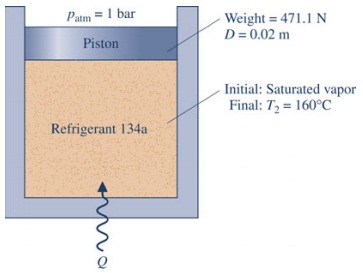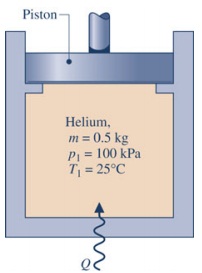Assignment:
Problem 1. A closed rigid tank whose volume is 1.5 m3 contains Refrigerant 134a, initially a two phase liquid vapor mixture at 10°C. The refrigerant is heated to a final state where temperature is 50°C and quality is 100%. Locate the initial and final states on a sketch of the ?? - ?? diagram. Determine the mass of vapor present at the initial and final states, each in kg.
Problem 2. Refrigerant 134a is contained in a piston-cylinder assembly, initially as saturated vapor the refrigerant is slowly heated until its temperature is 160°C. During the process, the piston moves smoothly in the cylinder. For the refrigerant, evaluate the work per unit mass, in kJ/kg.

Problem 3. A horizontal piston-cylinder assembly (closed system) contains 0.1 kg of water, initially at 1 MPa, 500°C. The water undergoes two processes in series:
Process 1-2: Constant-pressure cooling by compression until the volume becomes half of the initial volume. And point 2 is a mixture of vapor and liquid.
Process 2-3: Constant-volume cooling by heat transfer until the water cools to 25°C.
(1) Sketch process 1-3 on a T-v diagram.
(2) Neglect change of kinetic and potential energy, find the work (??1-2) and heat transfer (??1-2) in kJ for process 1-2.
(3) Neglect change of kinetic and potential energy, find the work (??2-3) and heat transfer (??2-3) in kJ for process 2-3.
Problem 4. A closed, rigid tank is filled with a gas modeled as an ideal gas, initially at 27°C and a gage pressure of 300 kPa. If the gas is heated to 77 °C, determine the final pressure, expressed as a gage pressure in kPa. The local atmospheric pressure is 1 atm.
Problem 5. A piston-cylinder assembly whose piston is resting on a set of stops contains 0.5 kg of helium gas, initially at 100 kPa and 25°C. The mass of the piston and the effect of the atmospheric pressure acting on the piston are such that a gas pressure of 500 kPa is required to raise it. How much energy must be transferred by heat to the helium, in kJ, before the piston starts rising? For the helium, assume ideal gas behavior with a constant ???? = 5/2 ??. Assume ???? is a constant at all temperatures.
